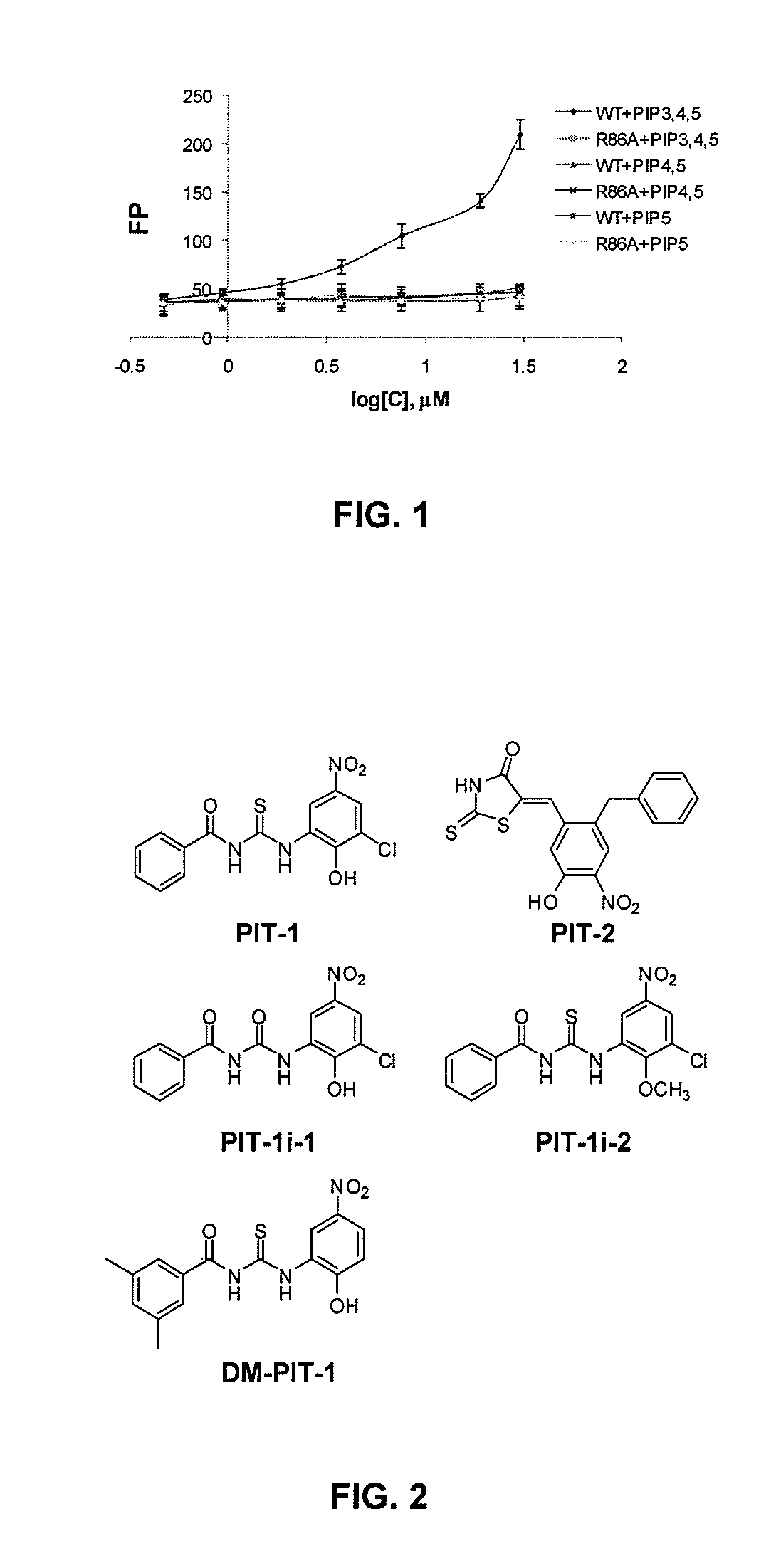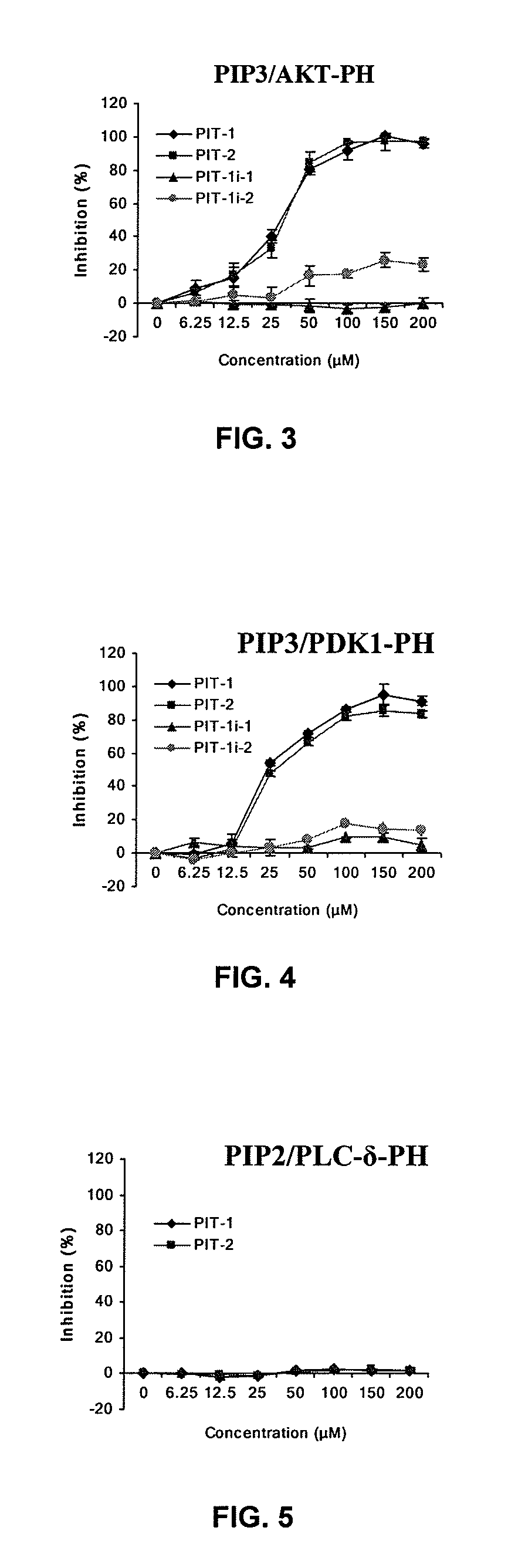Small molecule antagonists of phosphatidylinositol-3,4,5-triphosphate (PIP3) and uses thereof
a technology of phosphatidylinositol and small molecules, which is applied in the field of small molecule antagonists of phosphatidylinositol3, 4, 5triphosphate (pip3), can solve the problems of significant disruption by small molecules, and achieve significant anti-tumor activity in vivo, improve activity and ph domain selectivity
- Summary
- Abstract
- Description
- Claims
- Application Information
AI Technical Summary
Benefits of technology
Problems solved by technology
Method used
Image
Examples
example 1
Identification of PIT-1 and PIT-2 as Specific PIP3 Inhibitors
[0288]In order to identify compounds that disrupt the interaction between PIP3 and PH domains, a high-throughput fluorescence polarization (FP)-binding assay was developed using recombinant 1-123 amino acid N-terminal fragment of human Akt1 (also referred to herein simply as Akt), encompassing the PH domain (PH123 protein), and fluorescent NBD-labeled PIP3 molecule. The amino acid sequence of human Akt1 is publicly available as, for example, GenBank Accession No. NP—001014432.1 (SEQ ID NO:1), and the corresponding DNA sequence is publicly available as, for example, GenBank Accession No. NM—001014432. Briefly, 5 μM recombinant GST fusion proteins containing 1-123 a.a. N-terminal fragment of human Akt1 (PH 123) or 100 nM 441-551 a.a. region of human PDK1 were incubated with 15 nM TMR-labeled PIP3, PIP2, or PIP5 in buffer containing 50 mM Tris-HCl (pH 7.5), 150 mM NaCl, and 5 mM b-ME for 15 min at room temperature in the dark...
example 2
PIT-1 and PIT-2 Inhibit PIP3-Mediated Signaling
[0297]To begin characterizing cellular activity of PITs, a PH domain translocation assay was performed, measuring PIP3-induced association of GFP-fused PH domains with the plasma membrane. This method provides useful means for monitoring status of the PH domain / PIP3 binding in the intact cells. Varnai P et al. (1999) J Biol Chem 274:10983-9. Several PH-domain-containing proteins, which are known to bind PIP3 specifically and efficiently, were examined. As shown in FIG. 6, both PIT-1 and PIT-2 significantly inhibited the translocation of Akt and Btk (and similarly VAV2) to the plasma membrane in response to PDGF stimulation. Interestingly, these same compounds also suppressed the plasma membrane translocation of WAVE2, which lacks PH domain but binds PIP3 through the basic region. Oikawa T et al. (2004) Nat Cell Biol 6:420-6. This result illustrates PIP3-mimetic activity of PITs.
[0298]In contrast, no inhibitory effect was observed on the...
example 3
PIT-1 and PIT-2 Preferentially Reduce Viability of PTEN-Deficient Glioblastoma Cells
[0300]Based on the critical role of PIP3-dependent Aid signaling in the regulation of cell survival, the effect of PIT-1 on the cancer cell viability was tested. Cancer cells were seeded into 96-well plates (white plates for ATP assay; black plates for fluorescent assay; clear plates for MTS assay) at the density of 5-10×103 cells per well in 100 μl of the appropriate media. Compounds were added at a series of concentrations and incubated for different times. For the ATP assay, a luminescence-based commercial kit (CellTiter-Glo, Promega, Madison, Wis.) was used. Thirty microliters of cell lysis / ATP detection reagent was added to each well, mixed for 10 min at room temperature, and the luminescence was measured using a Wallac Victor 3 plate reader (Perkin-Elmer, Wellesley, Mass.). For the MTS assay, a CellTiter 96 AQueous Non-Radioactive Cell Proliferation Assay Kit (Promega, Madison, Wis., USA) was u...
PUM
| Property | Measurement | Unit |
|---|---|---|
| molecular weight | aaaaa | aaaaa |
| mean diameter | aaaaa | aaaaa |
| pH | aaaaa | aaaaa |
Abstract
Description
Claims
Application Information
 Login to View More
Login to View More - R&D
- Intellectual Property
- Life Sciences
- Materials
- Tech Scout
- Unparalleled Data Quality
- Higher Quality Content
- 60% Fewer Hallucinations
Browse by: Latest US Patents, China's latest patents, Technical Efficacy Thesaurus, Application Domain, Technology Topic, Popular Technical Reports.
© 2025 PatSnap. All rights reserved.Legal|Privacy policy|Modern Slavery Act Transparency Statement|Sitemap|About US| Contact US: help@patsnap.com



